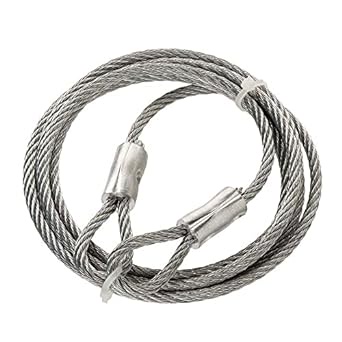Introduction:
In the realm of material handling and lifting operations, the choice of equipment plays a pivotal role in ensuring safety, durability, and efficiency. Stainless steel wire rope slings have emerged as a formidable solution, offering a combination of strength, durability, and corrosion resistance. This comprehensive guide delves into the characteristics, applications, best practices, and benefits associated with stainless steel wire rope slings, exploring how they have become a go-to choice for demanding lifting tasks.
Characteristics of Stainless Steel Wire Rope Slings:
-
Material Composition: Stainless steel wire rope slings are crafted from high-quality stainless steel, which is an alloy of steel, chromium, nickel, and other elements. This unique composition imparts exceptional strength, corrosion resistance, and durability to the slings.
-
Corrosion Resistance: One of the standout features of stainless steel wire rope slings is their resistance to corrosion. The chromium content in the stainless steel forms a protective oxide layer on the surface, shielding the slings from rust and corrosion. This makes them particularly suitable for use in challenging environments, such as marine or chemical processing applications.
-
Strength and Load Capacity: Stainless steel wire rope slings are known for their high tensile strength. The combination of the inherent strength of steel and the construction of wire ropes results in slings that can withstand heavy loads. This strength is crucial for lifting operations involving substantial weights.
-
Flexibility and Adaptability: The construction of wire ropes provides inherent flexibility to stainless steel slings, allowing them to conform to the shape of the load. This flexibility is advantageous when lifting irregularly shaped or sensitive loads, contributing to the versatility of these slings.
-
Longevity and Durability: Stainless steel wire rope slings are built to last. The corrosion-resistant properties, coupled with the inherent durability of stainless steel, contribute to a longer lifespan for these slings. This longevity makes them a cost-effective choice for industries where reliability and durability are paramount.
Applications of Stainless Steel Wire Rope Slings:
-
Maritime and Offshore Industries: Given their corrosion resistance, stainless steel wire rope slings find extensive use in maritime and offshore industries. These slings are well-suited for lifting and handling operations on ships, oil rigs, and other marine environments where exposure to saltwater and harsh conditions is prevalent.
-
Chemical Processing Plants: Stainless steel wire rope slings are ideal for applications in chemical processing plants. The resistance to corrosion makes them suitable for lifting and handling tasks involving hazardous chemicals and corrosive substances.
-
Construction and Infrastructure: In the construction industry, stainless steel wire rope slings are employed for lifting heavy construction materials, steel beams, and other components. Their strength and durability make them a reliable choice for demanding construction environments.
-
Manufacturing and Heavy Machinery: The versatility of stainless steel wire rope slings makes them valuable in manufacturing settings. They are used for lifting and moving heavy machinery and components, contributing to the efficiency of manufacturing processes.
Best Practices for Using Stainless Steel Wire Rope Slings:
-
Regular Inspection: Regular inspection of stainless steel wire rope slings is crucial to identify signs of wear, damage, or fatigue. Inspections should include a thorough examination of the entire length of the sling, focusing on areas near fittings and connection points.
-
Load Calculation and Working Load Limit (WLL): Accurate load calculations must be performed to ensure that the stainless steel wire rope slings are rated appropriately for the intended load. Adhering to the Working Load Limit (WLL) specified by the manufacturer is essential to prevent overloading and ensure safe lifting operations.
-
Proper Storage and Handling: Stainless steel wire rope slings should be stored in a clean, dry environment to prevent corrosion. When not in use, they should be properly coiled or hung to avoid kinks and bends. Care should be taken during handling to prevent damage to the slings.
-
Avoiding Abrasive Surfaces: While stainless steel is resistant to corrosion, abrasive surfaces can still cause wear and damage to the slings over time. Avoiding contact with rough or abrasive surfaces during lifting operations helps preserve the integrity of the slings.
Benefits of Stainless Steel Wire Rope Slings:
-
Corrosion Resistance for Harsh Environments: The primary benefit of stainless steel wire rope slings is their exceptional corrosion resistance. This makes them well-suited for applications in harsh environments, such as marine, chemical, or offshore settings, where exposure to corrosive elements is a constant challenge.
-
High Strength and Load Capacity: Stainless steel wire rope slings offer high tensile strength and impressive load-carrying capacities. This strength is a critical factor in lifting operations involving heavy loads, providing a reliable and robust solution for various industries.
-
Versatility and Flexibility: The inherent flexibility of stainless steel wire rope slings enhances their versatility. They can adapt to the shape of the load, making them suitable for lifting irregularly shaped or delicate objects. This adaptability contributes to the versatility of these slings across diverse applications.
-
Longevity and Cost-Effectiveness: The durability of stainless steel wire rope slings translates to a longer lifespan, making them a cost-effective investment. While the initial cost may be higher compared to some alternatives, the extended service life and reduced need for frequent replacements contribute to overall cost savings.
Conclusion:
Stainless steel wire rope slings stand as a testament to the combination of strength, durability, and corrosion resistance in the realm of material handling and lifting operations. Their application spans across various industries, including maritime, chemical processing, construction, and manufacturing, where the demand for reliable and resilient lifting equipment is paramount.
By adhering to best practices, including regular inspection, proper load calculations, and appropriate handling and storage, industries can fully harness the benefits of stainless steel wire rope slings. The corrosion resistance, high strength, versatility, and longevity offered by these slings make them an indispensable tool in the toolkit of modern material handling, contributing to the efficiency and safety of lifting operations across the United Kingdom and beyond.


No comments yet